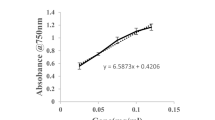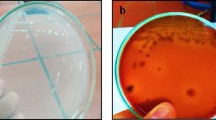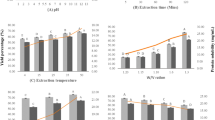Abstract
Recovery and alteration of fish protein from wastes and its use has been regarded as a promising alternative to develop useful products once polymer gels have a high capacity of water uptake. This study aims to produce hydrogel, a super absorbent biopolymer from modified fish protein, in order to evaluate the protein structure. In the modified proteins, analyses of the extent of modification of the lysine residues, electrophoresis, and electrometric titration were performed. In the hydrogels were realized assays of swelling water. The proteins with more modifications were shown as 63.5% and 75.9% of lysine residues, from fish protein isolate obtained with alkaline and acid solubilization, respectively. The modified protein in that same rate presented 332.0 and 311.4 carboxyl groups. Accordingly, the hydrogel produced from alkaline and acid isolates reached a maximum water uptake in 24 h of 79.42 and 103.25 gwater/gdry gel, respectively.





Similar content being viewed by others
References
Reguly, J. C. (1983). Biotecnologia dos processos fermentativos. Pelotas: Ed Universitária.
Cheng, G. X., Liu, J., Zhao, R. Z., & Yao, K. D. (1998). Journal of Applied Polymer Science, 67, 983–988.
Kristinsson, H. G., & Rasco, B. A. (2000). Journal of Agricultural and Food Chemistry, 48, 657–666.
Slizyte, R., Dauksas, E., Falch, E., Storro, I., & Rustad, T. (2005). Process Biochemistry, 40, 2021–2033.
Bechtel, P. J., Sathivel, S., & Oliveira, A. C. M. (2005). Alkali extracted protein fractions from salmon byproducts. Annual IFT Meeting 2005 New Orleans, Louisiana.
Batista, I., Pires, C., Nelhas, R., & Godinho, V. (2006). Acid and alkaline-aided protein recovery from Cape Hake by-products. Wageningen: Wageningen Academic Serial.
Chen, Y. C., & Jaczynski, J. (2007). Journal of Agricultural and Food Chemistry, 55, 9079–9088.
Røkaeus, S., & Undeland, I. (2007). Production of protein isolates from whole and gutted herring (Clupea harengus) using a pH shift method. Lisboa: WEFTA.
Guerard, F., Guimas, L., & Binet, A. (2002). Journal of Molecular Catalysis. B, Enzymatic, 19–20, 489–498.
Coello, N., Montiel, E., Concepcion, M., & Christen, P. (2002). Bioresource Technology, 85, 207–211.
Laufenberg, G., Kunz, B., & Nystroem, M. (2003). Bioresource Technology, 87, 167–198.
Kato, S., Kunisawa, N., Kojima, T., & Murakami, S. (2004). Journal of Chemical Engineering Japan, 37, 863–870.
Gebauer, R., & Eikebrokk, B. (2005). Bioresource Technology, 97, 2389–2401.
Arvanitoyannis, I. S., & Kassaveti, A. (2008). Int Journal of Food Science and Technology, 43(726), 745.
Rathna, G. V. N., & Damodaran, S. (2002). J. Apll. Polym. Sci., 85, 45–51.
Rathna, G. V. N., & Damodaran, S. (2001). Journal of Applied Polymer Science, 81, 2190–2196.
Rathna, G. V. N., & Gunasekaran, S. (2004). Polymer International, 53, 1994–2000.
Léonard, R., Lhernould, S., Carlué, M., Fleurat, P., Maftah, A., & Costa, G. (2005). Glycoconjugate J., 22, 71–78.
Zhang, S.-P., & Ping, W. (2006). Shengwu Jiagong Guocheng, 4, 4–8.
Kurniawan, L., Qio, G. G., & Zhang, X. Q. (2007). Biomacromolecules, 8, 2909–2915.
Solanki, K., Shah, S., & Gupta, M. N. (2008). Biocatalysis and Biotransformation, 26, 258–265.
Amiya, T., & Tanaka, T. (1987). Macromolecules, 20, 1162–1164.
Lu, G. H., & Chen, T. C. (1999). Journal of Food Engineering, 42, 147–151.
Hwang, D. C., & Damodaran, S. (1996). Journal of Agricultural and Food Chemistry, 44, 751–758.
Martins, V. G., Costa, J. A. V., & Prentice-Hernández, C. (2009). Quím. Nova, 32, 61–66.
Hwang, D. C., & Damodaran, S. (1997). Journal of the American Oil Chemists' Society, 74, 1165–1171.
Scopes, R. K. (1974). Analytical Biochemistry, 59, 277–282.
Hall, R. J., Trinder, N., & Givens, D. I. (1973). The Analyst, 98, 673–686.
Nozaki, Y., & Tanford, C. (1967). Journal of the American Chemical Society, 89, 736–749.
Laemmli, U. K. (1970). Nature, 227, 680–685.
Gehrke, S. H. (1993). In advances in polymer science 110—responsive gels: volume transitions II. In: K. Dusek (Ed.). Berlin: Springer.
Okuyama, Y., Yoshida, R., Sakai, K., Okano, T., & Sakurai, Y. (1993). J. Biomater. Sci. Polym. Ed., 4, 545–556.
Dave, A., Vaishnav, U., Desai, R., Shah, A., Ankleshwaria, B., & Mehta, M. (1995). Journal of Applied Polymer Science, 58, 853–859.
Pal, K., Banthia, A. K., & Majumdar, D. K. (2007). J. Mater. Sci. Mater Med., 18, 1889–1894.
Acknowledgements
Authors wish to thank The Coordination for Improvement of Higher Education Personnel in Brazil (CAPES) and National Council for Scientific and Technological Development of Brazil (CNPq) for financial support to carry out experiments.
Author information
Authors and Affiliations
Corresponding author
Rights and permissions
About this article
Cite this article
Martins, V.G., Costa, J.A.V., Damodaran, S. et al. Chemical Modification and Structural Analysis of Protein Isolates to Produce Hydrogel using Whitemouth Croaker (Micropogonias furnieri) Wastes. Appl Biochem Biotechnol 165, 279–289 (2011). https://doi.org/10.1007/s12010-011-9250-y
Received:
Accepted:
Published:
Issue Date:
DOI: https://doi.org/10.1007/s12010-011-9250-y




